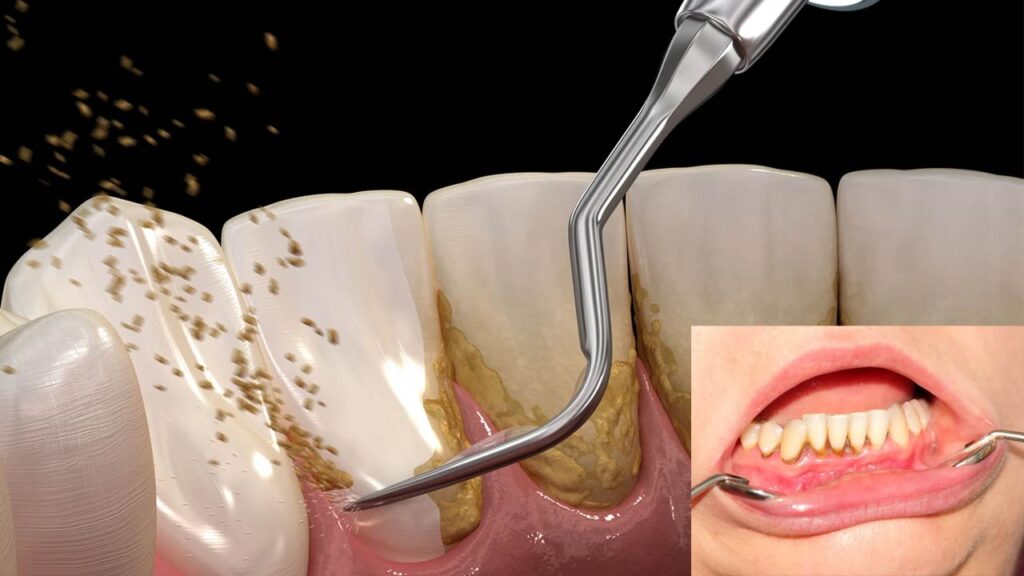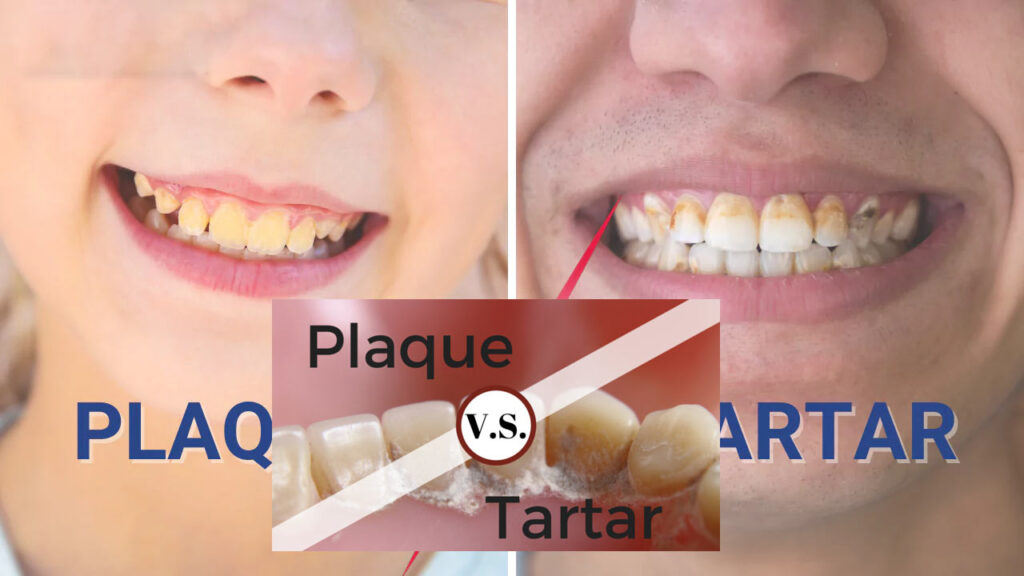Dental plaque and tartar are two common dental problems that can affect your oral health and appearance. But what are they exactly, and how can you prevent and treat them? In this article, we will explain everything you need to know about dental plaque and tartar, including:
- What is dental plaque and what causes it?
- What is tartar and how does it form?
- What are the differences between plaque and tartar?
- What are the consequences of plaque and tartar buildup?
- How can you remove plaque and tartar from your teeth?
- How can you prevent plaque and tartar from forming in the first place?
By the end of this article, you will have a better understanding of dental plaque and tartar, and how to keep your teeth healthy and clean.
What is dental plaque and what causes it?
Dental plaque is a soft, sticky film that forms on your teeth every day. It consists of bacteria, saliva, food particles, and other substances. The bacteria in plaque feed on the sugars and starches in the foods you eat, and produce acids that can damage your tooth enamel and cause cavities. Plaque also irritates your gums and can lead to gum disease.

Plaque is a natural occurrence in your mouth, but it can be harmful if you don’t remove it regularly. The best way to get rid of plaque is to brush your teeth twice a day with a fluoride toothpaste, and floss once a day to clean between your teeth. You should also visit your dentist every six months for a professional cleaning and checkup.
What is tartar and how does it form?
Tartar, also known as calculus, is a hard, yellowish or brownish substance that forms when plaque is not removed properly. Tartar is essentially calcified plaque that has hardened over time due to the minerals in your saliva. Tartar can form on the surface of your teeth, above or below the gum line.
Tartar is more difficult to remove than plaque, because it adheres firmly to your teeth. You cannot get rid of tartar by brushing or flossing alone. You need to see a dentist or a dental hygienist who can use special instruments to scrape or scale off the tartar from your teeth.
What are the differences between plaque and tartar?
Plaque and tartar are both forms of bacteria that accumulate on your teeth and gums. However, there are some key differences between them:
- Plaque is soft, sticky, and colorless, while tartar is hard, rough, and yellowish or brown.
- Plaque can be removed by brushing and flossing, but tartar can only be removed by a dental professional.
- Tartar creates more irritation and inflammation for the gum tissue and makes plaque harder to remove.
- Tartar increases the risk of tooth decay, gum disease, bad breath, tooth staining, and tooth loss.
What are the consequences of plaque and tartar buildup?
Plaque and tartar buildup can have serious consequences for your oral health and overall well-being. Some of the problems that can arise from plaque and tartar include:
Tooth decay:
The acids produced by plaque bacteria can erode your tooth enamel, creating holes or cavities in your teeth. Tooth decay can cause pain, sensitivity, infection, abscesses, and tooth loss if left untreated.
Gum disease:
Plaque bacteria can also infect your gums, causing them to become red, swollen, bleeding, or receding. This is known as gingivitis, the early stage of gum disease. If gingivitis is not treated, it can progress to periodontitis, a more severe form of gum disease that can damage the bone and tissue that support your teeth. Periodontitis can lead to loose teeth or tooth loss.
Bad breath:
Plaque and tartar can cause bad breath or halitosis due to the accumulation of bacteria and food debris in your mouth. Bad breath can affect your confidence, social life, and relationships.
Tooth staining:
Plaque and tartar can stain your teeth due to their color or due to the absorption of pigments from foods, drinks, tobacco, or medications. Stained teeth can affect your appearance and self-esteem.
Tooth loss: Plaque and tartar can ultimately result in tooth loss due to tooth decay or gum disease. Losing one or more teeth can affect your chewing ability, speech, facial structure, smile aesthetics, and quality of life.
How can you remove plaque and tartar from your teeth?
The best way to remove plaque from your teeth is to brush them twice a day with a fluoride toothpaste for two minutes each time. You should also floss once a day to clean between your teeth where plaque can hide. Additionally, you can use an antibacterial mouthwash or a tongue scraper to reduce the amount of plaque bacteria in your mouth.
The best way to remove tartar from your teeth is to visit your dentist or a dental hygienist every six months for a professional cleaning. They will use special instruments to scrape or scale off the tartar from your teeth. They may also polish your teeth to remove any stains or smooth any rough surfaces.
How can you prevent plaque and tartar from forming in the first place?
The best way to prevent plaque and tartar from forming on your teeth is to maintain good oral hygiene habits and a healthy diet. Here are some tips to prevent plaque and tartar:
- Brush your teeth twice a day with a fluoride toothpaste and a soft-bristled toothbrush. Make sure to brush all surfaces of your teeth, including the front, back, and chewing sides. Replace your toothbrush every three to four months or when the bristles become frayed.
- Floss once a day to remove plaque and food particles from between your teeth. Use about 18 inches of floss and wrap it around your middle fingers. Gently slide the floss between your teeth and curve it around each tooth. Move the floss up and down, scraping the sides of each tooth. Use a fresh section of floss for each tooth.
- Rinse your mouth with an antibacterial mouthwash after brushing and flossing. This can help kill any remaining plaque bacteria and freshen your breath. Follow the instructions on the label and do not swallow the mouthwash.
- Scrape your tongue with a tongue scraper or a toothbrush every morning. This can help remove any plaque bacteria that may have accumulated on your tongue overnight. Start from the back of your tongue and gently scrape forward. Rinse your mouth with water after scraping.
- Limit your intake of sugary and starchy foods and drinks, such as candy, cookies, cakes, soda, juice, bread, pasta, rice, and potatoes. These foods can feed the plaque bacteria and increase the production of acids that can damage your teeth. If you do consume these foods, try to brush your teeth or rinse your mouth with water as soon as possible.
- Drink plenty of water throughout the day to keep your mouth hydrated and wash away any food particles or plaque bacteria. Water also helps neutralize the acids in your mouth and prevent dry mouth, which can increase the risk of plaque and tartar formation.
- Eat more foods that are good for your teeth, such as cheese, yogurt, milk, nuts, fruits, vegetables, lean meats, eggs, and fish. These foods can provide essential nutrients for your teeth, such as calcium, phosphorus, vitamin C, vitamin D, and protein. They can also stimulate saliva production, which can help wash away plaque bacteria and remineralize your tooth enamel.
- Avoid smoking or using tobacco products, such as cigarettes, cigars, pipes, chewing tobacco, or snuff. Tobacco can stain your teeth, increase plaque and tartar buildup, cause bad breath, damage your gums, and increase the risk of oral cancer.
- Visit your dentist regularly for checkups and cleanings. Your dentist can examine your teeth and gums for any signs of plaque and tartar buildup, tooth decay, gum disease, or other oral problems. They can also perform a professional cleaning to remove any plaque and tartar that you may have missed with brushing and flossing. They can also give you personalized advice on how to improve your oral hygiene and prevent future problems.
Dental plaque and tartar are common dental problems that can affect your oral health and appearance if left untreated. Plaque is a soft, sticky film that forms on your teeth every day due to bacteria, saliva, food particles, and other substances. Tartar is a hard, yellowish or brownish substance that forms when plaque is not removed properly and hardens over time due to the minerals in your saliva.
Plaque and tartar can cause various problems for your teeth and gums, such as tooth decay, gum disease, bad breath, tooth staining, and tooth loss. Therefore, it is important to remove plaque and tartar from your teeth regularly by brushing twice a day with a fluoride toothpaste, flossing once a day, rinsing with an antibacterial mouthwash, scraping your tongue, visiting your dentist every six months for a professional cleaning, and following a healthy diet.
By following these tips, you can prevent plaque and tartar from forming on your teeth in the first place, and keep your smile healthy and beautiful.


1 thought on “Understanding Dental Plaque and Tartar”